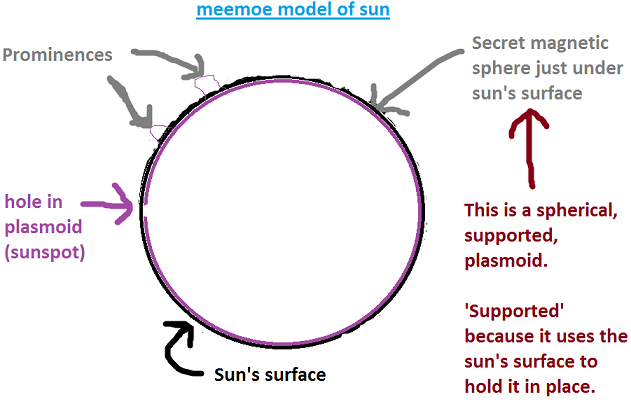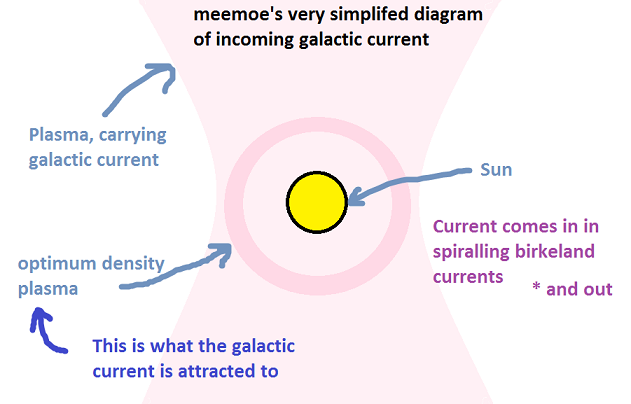It's arguable that the collisions would be
so violent that this single-channel configuration wouldn't be stable. So perhaps the electrons would burrow through the positive ions, creating their own sub-channel. Inside this channel, there would be no resistance, while on the edges, there would be particle collisions. This would likely develop a sheath of positive ions accelerated by electron drag in the same direction as the electrons. Since opposite charges traveling in the same direction generate opposing magnetic fields, they repel each other. So the electron stream will gain a sheath of positive ions traveling in the same direction, though this wouldn't be such a stable configuration
meemoe_uk wrote:It looks like the space plasma and solar corona are better, perhaps orders of magnitude better conductors than the sun itself. Therefore galactic current just flows around the sun.
That's an excellent point. Most people seem to think that a perfect vacuum is a perfect resistor, when actually, it's a perfect conductor, and yes, space itself should be an excellent conductor -- even better than the 6000+ K hydrogen plasma on the surface of the Sun. More on that below, but for now, the first question begged by this realization is whether or not a galactic current would flow through the heliosphere at all. The interstellar medium is less dense, and therefore an even better conductor, than the heliosphere.
meemoe_uk wrote:But it can still supply power to the sun via magnetic fields.
I'm not going to rule this out, but it will take a diagram to identify the actual configuration that you're proposing, so it can be evaluated. If the above is correct, the current doesn't even go through the heliosphere, which means that whatever magnetic field is powering the Sun is also powering us (?) begging the question of why we don't sense it. Or do we, and we just don't realize it?
meemoe_uk wrote:I'm not convinced 10^26 Watts power supply would show up in transmission space plasma. Industrial power lines conduct more than 10^8 Watts in a couple of cm radius of relatively very poor conductor compared to plasma and there is normally no glow. How many magnitudes of conductivity is hydrogen plasma a better conductor than aluminium? How many magnitudes of cross sectional area does a galactic current have over an industrial power line? How much more power is needed to make it glow? Are there any tricks hydrogen plasma can play to further increase its conductance? Glow comes from resistance to the motion of the electrons. At very high voltage I could imagine relativistic magnetic fields sectioning off the electrons from the ions entirely, making the plasma act like a super conductor.
Indeed! Since you actually seem to understand plasma discharges, let's work this through and see what we get.
Given sufficient voltage to initiate a dark discharge, from some point to some point, such that the discharge flows in some sort of proximity to the Sun, and given that 10^26 Watts are supplied (somehow) to the Sun, what would be the characteristics of that discharge?
To get such a current on a scale larger than the heliosphere itself, the electric field lines would be more-or-less straight at the scale of the heliosphere. So the discharge will start out following a more-or-less straight path (not including small-scale twists due to an external magnetic field, if present). In such an electric field, the electrons will go one way, and the positive ions will go the other. The electrons accelerate more easily, due to their smaller mass, but on this scale, we'd expect all of the particles to achieve relativistic speeds, resting inertia notwithstanding. Since opposing charge streams generate the same magnetic fields, both charge streams will pinch into discrete discharge channels, and the channels will merge together, due to the magnetic pinch effect. This has opposing charge streams flowing through the same place, meaning relativistic collisions between electrons and +ions. That would certainly be visible. Fancier things can happen, but the bottom line is that if the power is being transmitted by magnetic fields, then at the very least,
those would be detectable, if indeed we are able to detect the photons emitted by the Sun as a consequence.
meemoe_uk wrote:Lerner achieved fusion years ago.
Can you supply a reference for this?
meemoe_uk wrote:Lerner's device uses a small magnetic field to help plasmoids form. Once currents are in close proximity they fall into an energy well via Ampere's force law. The giga-tesla magnetic field required for fusion forms naturally at the nano scale at the bottom of the energy well.
So where is the giga-tesla magnetic field in the Sun?
meemoe_uk wrote:How long would the sun last under your model if all the potential fuel ignited at the same instance?
Well, it's one of the givens of your question that it would only last an instant. But in my model, the "fuel" is electrostatic potential, and unless otherwise disturbed (such as by a large impactor), the energy release is regulated. That's complicated, so I'll wait until I'm asked to explain that one.
meemoe_uk wrote:Super conductors expel all magnetic fields from their conducting medium.
I don't understand this.
meemoe_uk wrote:The sun itself is internally probably a good conductor, so again its wants to externalise magnetic fields. This way, a powerful magnetic field is concentrated into a thin radius near the surface of the sun, creating a huge energy potential. Any charged particles moving into this magnetic field will gain energy equivalent to a high energy particle collision.
Would we be able to measure these fields? The average field that we
do measure at the surface is just 1 Gauss.
meemoe_uk wrote:The only stuff focus fusion requires are the objects that have astro-physical jets, which resemble plasmoid collapse, i.e. the exotic objects.
So a focus fusion star converts bi-polar jets into discrete plasmoids? Has this ever been observed? Jets that
have not been converted have certainly been observed.
viscount aero wrote:So you
do believe in the standard model in large part. Millisecond pulsars are verboten in EU

You don't believe those are sites of electrical stress shedding charge in timed pulses? Perhaps I should ask, apart from saying "The Universe is electric! The Universe is electric!", what about that do you actually believe? Almost none of what you are saying has anything to do with the electric cosmos. Millisecond pulsars as actual spinning objects reveal a primacy of gravity. EU is not about gravity dominating the cosmos.
Just about the only thing that my toroidal plasmoid (i.e., "natural tokamak") model of millisecond pulsars has in common with the standard model is that they are capable of pulsing. They are magnetically confined, not gravitationally. They are toroidal, not spherical. They are made of low-density plasma, not impossibly high-density magic matter. So when I'm done, there really isn't anything left of the standard model -- we're just left with the pulsating data.
But no, I don't believe that pulsars are sites of electrical stress shedding charge in timed pulses. A lightning strike here on Earth lasts longer than a millisecond, and then it takes minutes for the potential to build back up again in that portion of the cloud. Thinking that a far larger discharge could happen faster is strained, but recharging in a fraction of a millisecond is just beyond belief. Where in nature do you see this kind of rapid change from conductivity to resistance and back again, in 1/1000 of a second?
As concerns whether or not the Universe is electric, my CFDL model of the Sun (and of the Earth) is EM, and my "natural tokamak" (i.e., toroidal plasmoid) model of exotic stars is EM. So there's a lot of EM, a little bit of fusion, and just a smidgeon of gravity in these theories. Clearly, the principles of EM dominate, so yes, I wholeheartedly believe that the Universe is electric. Just not the way the EU has it. But they didn't invent EM, so they can't claim that they own it.
viscount aero wrote:Do you believe in the big bang, too?
I don't think that we have enough information to say. The redshift data are highly unreliable. In the absence of evidence, there is no reason to believe that the Universe is expanding.
viscount aero wrote:I don't see how something at any temperature necessarily disqualifies it from creating conductance or resistance.
At high temperatures, electrons are liberated in atomic collisions, and then they're free to respond to whatever electric field might be present. Hence everything becomes an excellent conductor at high temps, including hydrogen, which otherwise is one of the best resistors.
viscount aero wrote:Moreover, if the superheated pure plasma state poses no resistance at all, or virtually none, then why do you insist that "The Universe is electric! The Universe is electric!" when apparently it cannot be. Plasma itself cannot be electric. So why do you believe it is?
This is precisely the argument of the mainstream -- in a highly conductive medium, there is no way to get charge separations, because there is no resistance to keep them separate. Therefore, all plasma in the Universe is quasi-neutral (i.e., the electrons have been liberated from the atoms, but they're still in the general vicinity, and any given parcel of plasma is net neutral). But this simply isn't true. Magnetic pressure can separate charges, and so can electron degeneracy pressure. Nevertheless, I owe you a compliment for perceiving the problem -- most in the EU don't realize what a problem conductivity actually poses for EU theories. Galactic currents require galactic charge separations, and voltage regulators to get sustained currents, instead of instantaneous absolute discharges. None of these pieces have been identified in EU theory.

